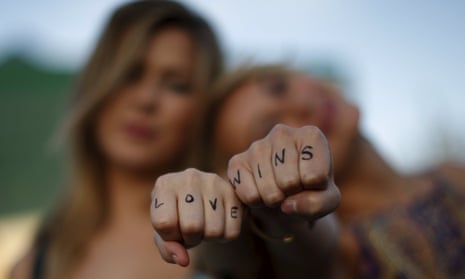In the wake of last week’s historic Supreme Court decision mandating that same-sex marriage be legal nationwide, the hashtag #LoveWins tore through Twitter – 5m tweets just on Friday, more over the weekend. With the hashtag came the question: How did you get it to make a rainbow heart on the end of the hashtag like that? I want one! And the answer: I didn’t! Twitter put the rainbow heart on all #LoveWins tweets automatically.
This was a sweet feature, a way to make the Twitter timeline visually represent a nominal commitment to gay rights (along the lines of other companies’ graphical updates this weekend, like Uber’s rainbow-farting cars), not to mention reflecting the delight of marriage equality supporters.
But the rainbow stamp may have had an additional effect. Normally, any trending hashtag gets inundated with people intentionally trying to subvert its goals – sometimes benevolently or mischievously, sometimes for evil. But while I saw right-wingers snipe about “that hashtag” this weekend, they seemed more likely to complain obliquely, rather than jumping in to poison a joyful conversation.
Were anti-gay bigots less likely to hijack the #LoveWins hashtag because it meant they’d have a rainbow heart in every tweet? It seems plausible. As the recent belated furor over the Confederate battle flag makes clear, symbols have profound importance well beyond their apparent value. A rainbow heart emoji is technically just some pixels on a screen, but it’s also much more: an emblem; a statement. Being required to flaunt the imagery of your enemy if you want to attack them might just make the attack lose its appeal. Imagine telling the Westboro Baptist Church that they could protest funerals, but they had to do it wearing nothing but rainbow Speedos.
“A picture is worth a thousand words” is the hoariest of clichés, but that’s partly because it’s true; we’ve seen some especially striking examples in the last few years. Activists and advocates have generated billions of words about police violence, white supremacy, and ingrained systemic racism – 18m tweets mentioning Ferguson were sent in August of 2014 alone. Several thousand more of those words came in the form of opinion pieces and essays, some of them by my colleagues here at the Guardian. But I suspect nothing written on these subjects in the last two years will prove to be as absolutely indelible as the photograph of Edward Crawford throwing tear gas back at the cops, or the one of Bree Newsome removing the Confederate flag.
If you’re sufficiently soulless, many things are easy. Stepping sarcastically into an earnest, important hashtag like #LoveWins or #BlackLivesMatter is laughably simple if you’re the kind of person who doesn’t mind mocking or ignoring others’ pain or soul-searching. But it’s less simple to deploy a profound image in a sarcastic way. Short of vandalizing the image itself, how do you subvert its power? It’s not impossible, for sure – few things are impossible if you’re sufficiently soulless – but it’s harder, maybe. The image retains its impact independent of whatever toxic remark you want to make.
Twitter’s capacity to add icons to hashtags has the potential to be more than a cute novelty. For that to happen, the company would have to think deeply about the possible impacts of imagery, and maybe dedicate itself to supporting causes less universally Silicon-Valley-approved than gay marriage. But the effect could be great, both as an effective visual statement of Twitter’s commitments and as a move towards creating a space unfriendly to trolling. What if every tweet about #Ferguson had automatically appended a raised black fist?

